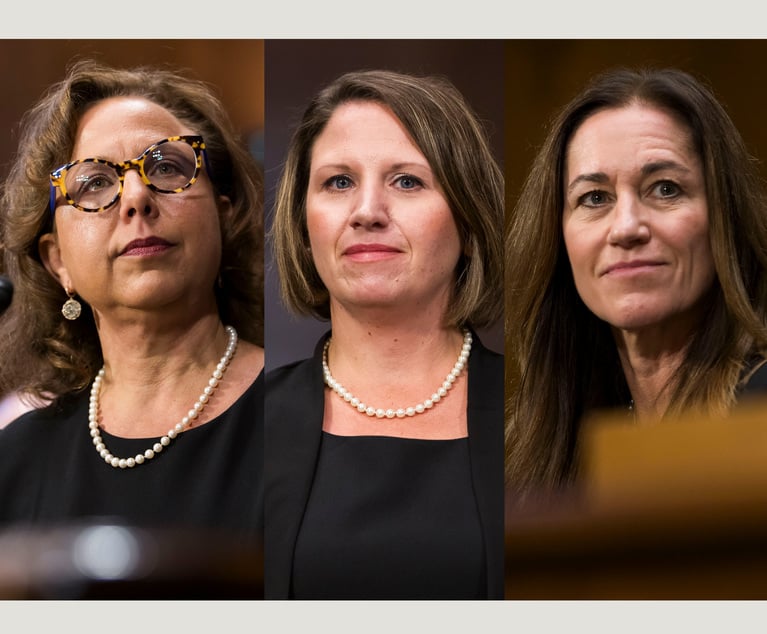SCOTUS to Decide How 'Super' Superfund Really Is
In June, the U.S. Supreme Court agreed to hear Atlantic Richfield v. Christen (No. 17-1498), which is poised to be one of the court's most significant CERCLA (or Superfund) cases in recent years.
July 24, 2019 at 11:13 AM
11 minute read
 Pete Keays of Hangley Aronchick Segal Pudlin & Schiller
Pete Keays of Hangley Aronchick Segal Pudlin & Schiller
In June, the U.S. Supreme Court agreed to hear Atlantic Richfield v. Christen (No. 17-1498), which is poised to be one of the court's most significant CERCLA (or Superfund) cases in recent years. At issue is whether CERCLA bars a group of property owners at a major Superfund site from bringing a state common law claim against Atlantic Richfield Corp. (ARCO) for damages to cover the cost of remedial work that the property owners wish to conduct beyond the work EPA ordered ARCO to perform on their properties.
Fundamentally, Atlantic Richfield is about the scope and preemptive effect of the EPA's authority over the cleanup of contaminated sites, the extent to which parties performing remediation may be held liable for work beyond that which the EPA determines is necessary, and the rights of landowners to even perform such work. The outcome of the case could have profound implications for the Superfund program and contaminated sites throughout the country.
The Case
ARCO's predecessor operated a large copper smelter in southwestern Montana for nearly a century. The smelter stack—which, at 585 feet, is the tallest freestanding masonry structure in the world—emitted arsenic and lead that eventually settled onto the surrounding landscape. The smelter closed in 1980, and in 1983 the EPA designated the smelter and a 300-square-mile area surrounding it (which had been impacted by the stack's emissions) as a Superfund site. Since 1984, ARCO has been conducting extensive investigation and remediation at the site pursuant to an EPA order and in accordance with a cleanup plan the EPA selected.
The Atlantic Richfield litigation began in 2008 when plaintiffs, whose properties are located within the site's boundaries, sued ARCO in Montana state court. Plaintiffs asserted only state law claims, including a claim for restoration damages intended to cover the cost of remedial work they would like to perform in excess of the work EPA ordered ARCO to perform on their properties. As relevant to the case, plaintiffs wish to conduct work implementing a lower cleanup level for arsenic (8 ppm as opposed to EPA's 250 ppm) and a deeper soil excavation level (two feet as opposed to EPA's 18 inches). They also want to construct groundwater barriers and trenching that EPA concludes could exacerbate contamination.
ARCO filed a motion for summary judgement on the restoration damages claim (plaintiffs' claim), which it argued was barred by CERCLA for the reasons discussed below. The Montana Supreme Court affirmed a lower court's denial of ARCO's motion, and the U.S. Supreme Court granted ARCO's petition for certiorari.
Superfund
Before delving into the substance of Atlantic Richfield, a brief primer on the key CERCLA provisions at issue is warranted.
CERCLA provides the EPA with immense authority over the remediation of contaminated sites, including the authority to select the cleanup plan, Section 104(c)(4), and to order or enter agreements with parties to implement that plan, Section 106(a). To minimize the delays that litigation over the EPA's cleanup plans would cause, Section 113(h) strips the federal courts of jurisdiction to review “challenges” to the EPA's cleanup plans (hereinafter referred to as Section 113(h) challenges) except under certain narrow circumstances that are not relevant to this case. Section 122(e)(6) further strengthens the EPA's control over cleanup by providing that once remedial investigation has begun, “potentially responsible parties” (PRPs) are prohibited from “undertaking any remedial action” without the EPA's authorization.
Generally speaking, these provisions coalesce to create an appealing level of certainty and finality regarding the remediation that settling parties will be required to perform. This is an alluring carrot to encourage settlement, for as the EPA acknowledges, “the main incentive for a responsible party to enter into a CERCLA consent decree … is to fix the party's cleanup obligations.”
Although settlement with the EPA may fix a party's CERCLA liability, settling parties may still be liable to third parties for certain state law claims thanks to CERCLA's savings clauses, one of which provides that “nothing in [CERCLA] shall be construed or interpreted as preempting any state from imposing any additional liability or requirements with respect to the release of hazardous substances within such state.”
Questions Presented and Potential Consequences
ARCO advances three arguments for why the plaintiffs' claim should be barred, all of which the Montana court rejected, and which are the subjects of the three questions presented in ARCO's successful cert petition.
- Does plaintiffs' restoration claim constitute a Section 113 challenge?
ARCO asserts that plaintiffs' claim constitutes a challenge to the EPA's cleanup plan and is therefore barred under Section 113(h). CERCLA does not define what constitutes a Section 113(h) challenge. Although the Supreme Court has not yet examined the question, lower courts generally apply a “broad standard for what constitutes a challenge,” as in Cannon v. Gates, 538 F.3d 1328, 1336 (10th Cir. 2008). The general consensus is that a claim need not expressly or directly attack the remedy—nor even have been brought against the EPA—for that claim to be barred as a Section 113(h) challenge. See e.g., Pakootas v. Teck Cominco Metals, 646 F.3d 1214, 1220-23 (9th Cir. 2011).
The Montana court ruled that the plaintiffs' claim is not a Section 113(h) challenge, reasoning that plaintiffs are merely seeking funds to do additional remediation on their own properties, and “are not seeking to interfere with the EPA's plan,” see Atlantic Richfield v. Montana Second Judicial District Court, 2017 MT 324, ¶ 17. ARCO argues that the Montana court construed Section 113(h) too narrowly and points to the specific components of the plaintiffs' proposed work noted above, which they and the EPA contend are in direct conflict with the EPA's plan.
Although the restoration damages plaintiffs seek are not widely available in other states, if the Supreme Court espouses a narrow view of what constitutes a Section 113(h) challenge, that will likely embolden stakeholders to file suits testing various claims that implicate pending cleanup plans at other sites. Moreover, although the claim in Atlantic Richfield was brought by citizens trying to effectuate heightened remediation, the bar against Section 113(h) challenges doesn't discriminate between claims effectively seeking more remediation and claims seeking less remediation. Thus, an opinion construing Section 113(h) narrowly will not only encourage lawsuits similar to Atlantic Richfield, it may also embolden PRPs to challenge—either directly or indirectly—the EPA cleanup plans in hopes of reducing the associated cleanup costs. The outcome of such attempts may ultimately constrain the largely unreviewable authority to control cleanups that the EPA currently wields.
If the Supreme Court reverses the Montana court and rules that the plaintiffs' claim is an impermissible Section 113(h) challenge, it will need to confront a question with additional implications for future challenges to pending the EPA cleanup plans. Plaintiffs argue that because the Section 113(h) bar against “challenges” strips only “the federal courts” of jurisdiction the Section 113(h), it does not apply to claims brought in state court. ARCO argues that because § 113(b) gives the federal courts “exclusive original jurisdiction over all controversies arising under CERCLA,” Section 113(b) and Section 113(h), when read together, deprive state courts of jurisdiction over claims that constitute Section 113(h) challenges. A ruling adopting plaintiffs' view could further open the door to claims in state courts—including claims that might constitute impermissible Section 113(h) challenges had they been brought in federal court.
- Is the restitution claim barred by the doctrine of conflict preemption?
ARCO argues that the plaintiffs' claim is also barred by operation of the conflict preemption doctrine. Grounded in the Supremacy Clause, conflict preemption dictates that when a conflict arises between federal and state law such that an application of the state law “stands as an obstacle to the accomplishment and execution of the full purposes and objectives of Congress,” federal law prevails, see Hines v. Davidowitz, 312 U.S. 52, 67 (1941). ASARCO contends that because components of the plaintiffs' remedy conflict with the EPA's remedy “granting …restoration damages … would usurp the EPA's exclusive statutory authority to select and implement the appropriate remedy… [and] thwart CERCLA's central objectives of promoting settlement and preventing multiple, conflicting remedies at a Superfund site.” Relying in significant part on CERCLA's savings clause, the Montana court rejected ARCO's argument.
Although the conflict preemption inquiry is inherently fact dependent, the Supreme Court's analysis of the issue may provide useful guidance in future litigation over CERCLA conflict preemption. Moreover, given the Montana court's reliance on the savings clauses—which, as the parties appear to agree, does not categorically bar the application of conflict preemption—the Supreme Court may expound for the first time on the contours of CERCLA's savings clauses and the types of claims they do (and do not) preserve.
- Are plaintiffs PRPs?
ARCO also argues that Section 122(e)(6) bars plaintiffs from conducting the work underpinning their claim because the work was not approved by the EPA, and therefore that the claim must fail. In rejecting ARCO's argument, the Montana court reached an eyebrow raising result, holding that they are not PRPs for purposes of Section 122(e)(6) because they had never been “designated” as such through either a judicial determination or a settlement with the EPA.
The Montana court's holding is at odds with the general understanding that although CERCLA does not define the term PRP, it encompasses the four categories of persons identified in Section 107(a), including current site owners, see United States v. Atlantic Research, 551 U.S. 128, 131–32 (2007), and that PRP status attaches “automatically” and “solely by reference to the party's relationship to a hazardous waste site” without the need for an agreement or judicial determination.”
A ruling by the Supreme Court that PRP status requires an affirmative determination to that effect would narrow the EPA's authority to control and coordinate remedial efforts across the entirety of a Superfund site, which could lead to a patchwork of remedies implemented by individual landowners rather than a single, sitewide approach. Additionally, if the Supreme Court adopts the Montana court's view that litigation or formal settlement is required in order for a party to be deemed a PRP for purposes of Section 122(e)(6), the EPA may be incentivized to cast a winder net when determining which Section 107(a) parties to target for participation in the cleanup processes. Indeed, it is not uncommon for the EPA to ignore individuals and other Section 107(a) parties that did not cause contamination, but that may change if the EPA believes that sparing such parties may deprive it of the authority to control the cleanup on those parties' properties.
Conversely, if the court rules that plaintiffs are PRPs, Section 122(e)(6) could end up severely restricting the rights of individual landowners at contaminated sites to perform work on their land that might be deemed an unauthorized “remedial action” under CERCLA's broad definition of that term, see Section 101(24).
Finally, the impact of a ruling that the plaintiffs are not PRPs could have implications well beyond Section 122(e)(6). The term “potentially responsible party” appears in the statute 33 times across provisions dealing with many facets of CERCLA's complex remediation and liability schemes. Any shift in the widely accepted understanding of this critically important term will spark additional litigation and could ultimately have major consequences for other key CERCLA provisions.
Conclusion
An affirmance of the Montana c ourt's decision will lead, at a minimum, to a proliferation of litigation (and associated cleanup delays) regarding pending the EPA cleanup plans. Such a result may also lead to a narrowing or weakening of the EPA's authority over cleanups, and a broadening of the scope of available private party remedies. Moreover, by widening the scope of claims that settling parties may still face, and by creating a new level of uncertainty as to whether the EPA's remedy will in fact be the final remedy for which a prospective settling party will ultimately be held responsible, an affirmance will very likely diminish the incentive to settle with the EPA. Conversely, a reversal would further strengthen the EPA's hand in remedy selection and implementation, constrict the rights of property owners and other third parties to bring claims against settling parties, and possibly restrict what property owners on contaminated sites may do on their property.
Pete Keays is an attorney in the environmental practice group at Hangley Aronchick Segal Pudlin & Schiller. He can be reached at 215-496-7034 or [email protected].
This content has been archived. It is available through our partners, LexisNexis® and Bloomberg Law.
To view this content, please continue to their sites.
Not a Lexis Subscriber?
Subscribe Now
Not a Bloomberg Law Subscriber?
Subscribe Now
NOT FOR REPRINT
© 2025 ALM Global, LLC, All Rights Reserved. Request academic re-use from www.copyright.com. All other uses, submit a request to [email protected]. For more information visit Asset & Logo Licensing.
You Might Like
View All
Pa. Federal District Courts Reach Full Complement Following Latest Confirmation

The Defense Bar Is Feeling the Strain: Busy Med Mal Trial Schedules Might Be Phila.'s 'New Normal'
7 minute read
Federal Judge Allows Elderly Woman's Consumer Protection Suit to Proceed Against Citizens Bank
5 minute read
Judge Leaves Statute of Limitations Question in Injury Crash Suit for a Jury
4 minute readTrending Stories
- 1January Petitions Press High Court on Guns, Birth Certificate Sex Classifications
- 2'A Waste of Your Time': Practice Tips From Judges in the Oakland Federal Courthouse
- 3Judge Extends Tom Girardi's Time in Prison Medical Facility to Feb. 20
- 4Supreme Court Denies Trump's Request to Pause Pending Environmental Cases
- 5‘Blitzkrieg of Lawlessness’: Environmental Lawyers Decry EPA Spending Freeze
Who Got The Work
J. Brugh Lower of Gibbons has entered an appearance for industrial equipment supplier Devco Corporation in a pending trademark infringement lawsuit. The suit, accusing the defendant of selling knock-off Graco products, was filed Dec. 18 in New Jersey District Court by Rivkin Radler on behalf of Graco Inc. and Graco Minnesota. The case, assigned to U.S. District Judge Zahid N. Quraishi, is 3:24-cv-11294, Graco Inc. et al v. Devco Corporation.
Who Got The Work
Rebecca Maller-Stein and Kent A. Yalowitz of Arnold & Porter Kaye Scholer have entered their appearances for Hanaco Venture Capital and its executives, Lior Prosor and David Frankel, in a pending securities lawsuit. The action, filed on Dec. 24 in New York Southern District Court by Zell, Aron & Co. on behalf of Goldeneye Advisors, accuses the defendants of negligently and fraudulently managing the plaintiff's $1 million investment. The case, assigned to U.S. District Judge Vernon S. Broderick, is 1:24-cv-09918, Goldeneye Advisors, LLC v. Hanaco Venture Capital, Ltd. et al.
Who Got The Work
Attorneys from A&O Shearman has stepped in as defense counsel for Toronto-Dominion Bank and other defendants in a pending securities class action. The suit, filed Dec. 11 in New York Southern District Court by Bleichmar Fonti & Auld, accuses the defendants of concealing the bank's 'pervasive' deficiencies in regards to its compliance with the Bank Secrecy Act and the quality of its anti-money laundering controls. The case, assigned to U.S. District Judge Arun Subramanian, is 1:24-cv-09445, Gonzalez v. The Toronto-Dominion Bank et al.
Who Got The Work
Crown Castle International, a Pennsylvania company providing shared communications infrastructure, has turned to Luke D. Wolf of Gordon Rees Scully Mansukhani to fend off a pending breach-of-contract lawsuit. The court action, filed Nov. 25 in Michigan Eastern District Court by Hooper Hathaway PC on behalf of The Town Residences LLC, accuses Crown Castle of failing to transfer approximately $30,000 in utility payments from T-Mobile in breach of a roof-top lease and assignment agreement. The case, assigned to U.S. District Judge Susan K. Declercq, is 2:24-cv-13131, The Town Residences LLC v. T-Mobile US, Inc. et al.
Who Got The Work
Wilfred P. Coronato and Daniel M. Schwartz of McCarter & English have stepped in as defense counsel to Electrolux Home Products Inc. in a pending product liability lawsuit. The court action, filed Nov. 26 in New York Eastern District Court by Poulos Lopiccolo PC and Nagel Rice LLP on behalf of David Stern, alleges that the defendant's refrigerators’ drawers and shelving repeatedly break and fall apart within months after purchase. The case, assigned to U.S. District Judge Joan M. Azrack, is 2:24-cv-08204, Stern v. Electrolux Home Products, Inc.
Featured Firms
Law Offices of Gary Martin Hays & Associates, P.C.
(470) 294-1674
Law Offices of Mark E. Salomone
(857) 444-6468
Smith & Hassler
(713) 739-1250





